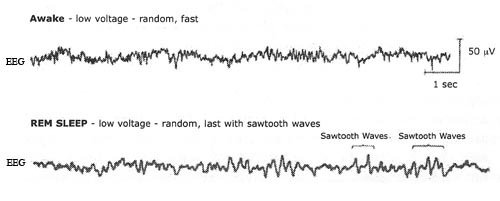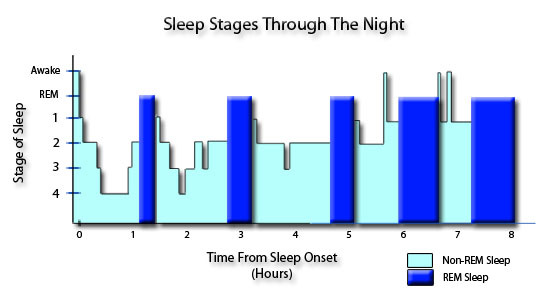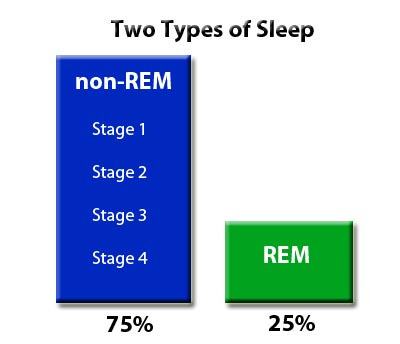
| Connect & Subscribe |
The Five Stages Of Sleep & The Journey Through The Night
 Sleep Step 1 |
Step 2 |
Step 3 |
Step 4 |
Step 5 |
Step 6
Sleep Step 1 |
Step 2 |
Step 3 |
Step 4 |
Step 5 |
Step 6
While sleep in the perspective of those experiencing it may seem more or less the same throughout the night, this couldn't be further from the truth.
Sleep is not one homogeneous state, but rather a progression through various states with extremely unique characteristics.
In total, there are five stages of sleep that can be readily distinguished from each other.
In other words, sleep is not just sleep! Life in slumber is a bit more nuanced than that, so let's take out the fine-toothed comb and examine it a little closer.
Table of Contents for the Stages of Sleep
The Two Main Types Of Sleep
Sleep can be divided into two entirely different behavioral states: REM (rapid eye movement) sleep, and non-REM sleep.
Additionally, non-REM sleep can be subdivided into 4 sub-stages, distinguishable by levels of EEG (a measurement for the bioelectric activity of the brain) visible during polysomnographic recordings. Each successive stage of non-REM sleep is indicative of a deeper sleep, with stage 1 as the lightest and stage 4 as the deepest. (Note: The sleep science community has more recently combined non-REM stages 3 and 4 into one stage, stage 3.)
A typical night's sleep consists of 75% non-REM sleep and 25% REM sleep. So a basic picture we get of sleep looks like this:
But beyond this simplified view, there is much more that can be said about both the characteristics of these two types of sleep and the way we move between their distinct stages of sleep throughout the night. We'll start by examining the characteristics of REM sleep before moving on to more closely examine the stages of non-REM sleep.
REM Sleep
What many regard as the most exciting stage of sleep, REM sleep is the stage where dreams occur. This connection between REM sleep and dreaming was first made in 1953 by our own Dr. Dement, as well as his fellow student Eugene Aserinsky and their teacher Nathaniel Kleitman.

Cool Stuff!
The stages of sleep were first described in 1937 by Alfred Lee Loomis, an American also known for significant work in developing the radar. Loomis and his coworkers used EEG recordings to classify 5 different levels of sleep that they referred to using the letters A to E.
When Dement and Kleitman discovered that REM sleep was a distinct state in 1953, it led them to reclassify the stages of sleep, separating REM from the other four stages of non-REM and giving us the model we use today.
 In REM sleep, the sleeper's eyes move in conjunction with his or her vision in the dream world. This is known as the scanning hypothesis.
In REM sleep, the sleeper's eyes move in conjunction with his or her vision in the dream world. This is known as the scanning hypothesis.
Eye Movements: The rapid eye movements for which REM sleep takes its name are a result of the brain trying to scan the events in the dream world. In other words, if one looks left and right during a dream, the sleeper's actual eyes will follow the dream gaze and move left and right under his or her eyelids. This is known as the scanning hypothesis, and you can read about some very cool studies that were used to prove it on the REM sleep page here.
In many ways these eye movements during REM sleep are entirely indistinguishible from the eye movements that occur during wakefulness. In both cases they are characterized by darting movements and binocularly synchronicity, meaning that both eyes move together. There are also, however, features of eye movements during REM sleep that are not real similar at all to that of wakefulness. Namely, during REM sleep there is a lack of eye centering and fixation, which are essential to waking sight, but a presence of occasional slow, drifting movements that never occur during wakefulness.
High Brain Activity: In order to conjure a dream, as you might imagine, the brain has to be highly active. In waking life the brain perceives and reacts to the world around a person. During dreaming the brain is not only perceiving and reacting, but also creating the environment. Thus, it makes sense that mental activity is very high during REM sleep.
 Brain activity during REM sleep is very comparable to activity during wakefulness, as evidenced in these EEG recordings showing very fast, quick waves in both states.
Brain activity during REM sleep is very comparable to activity during wakefulness, as evidenced in these EEG recordings showing very fast, quick waves in both states.
Awareness During SP
Interestingly, this REM atonia can spill over into wakefulness sometimes, giving rise to an experience known as awareness during sleep paralysis, or ASP.
ASP actually happens to most people at least once during their lifetime, and for those who experience it frequently it can be quite alarming.
Paralysis: Another characteristic of REM sleep is paralysis. If we were not paralyzed at this stage of sleep our entire body would be free to follow our eyes in acting out the dream and we would undoubtedly do some crazy things, not to mention things that would be very dangerous and/or not conducive to a good night's sleep (this actually happens in a condition called REM Sleep Behavior Disorder, which you can read about here).
REM paralysis is achieved by the REM atonia system, which creates a blockage of final nerve pathways, essentially inhibiting directions to react given by the brain from reaching the muscles. However, not every muscle group is paralyzed. The diaphragm functions to let us breathe, smooth muscle groups such as the urinary sphincter work, as do the eye muscles, which has given researchers much to study in REM sleep.
A wonderful simplification of this information, and a great way to think about REM sleep, is below:
Dr. D's Sleep Book Says...
"The simplest definition of REM sleep is a highly active brain in a paralyzed body."
Non-REM Sleep
Unlike REM sleep, the sleeper is not fully paralyzed during non-REM sleep. In fact, non-REM is characterized by continuous low-level muscle movements in the neck and jaw muscles.
The sleeper can also more commonly roll around and shift positions during non-REM, but movement is still typically very infrequent compared to wakefulness, as you might cunningly have imagined ;-) (This is to say nothing of the intriguing occurrences of such events as sleepwalking and sleep terrors though!)
Throughout the night, your body progresses in and out of the stages of non-REM sleep, and each stage has its own very unique characteristics.
Stage 1
Stage 1 sleep is a transition period from wakefulness to the other 3 stages of non-REM sleep. It is of short duration, usually lasting only from 1 to 7 minutes. Stage 1 sleep is characterized by low voltage, mixed frequency EEG, as well as some slow, rolling eye movements and some relatively higher EMG activity . The brain activity is shown below in the following EEG recording
. The brain activity is shown below in the following EEG recording .
.

Stage 2
Stage 2 makes up the bulk of an average person's sleep each night, around 40 to 45 percent. A sleep researcher can easily recognize stage 2 sleep because of the presence of sleep spindles and K-complexes in the EEG waves. A sleep spindle is a rapid wax and wane of the EEG waves in a 1 to 2 second interval, while a K-complex is a large wax and wane of the wave that somewhat resembles a mountain.

Stage 3
Stage 3 and stage 4 are similar and both fall into the category of slow wave sleep. They are so named because of the high amplitude waves in the EEG. In order to qualify as stage 3 sleep, these slow waves must be present in no more than 50 percent of the epoch. The waves are also referred to as delta waves.

Stage 4
Stage 4 is the other slow wave sleep period. In order to qualify as stage 4 sleep the high amplitude delta waves must be present in more than 50 percent of the epoch, like in the EEG recording below.

Putting It All Together - The Journey Through The Night
Did you know just a regular night's sleep had so many elements to it? Not many people know really about how complex sleep really is, or how many changes and events occur in just a single, ordinary night. Now, we're going to leave the detailed characteristics of the stages of sleep and take a look at how they all fit together.
The following graph is one of the best visual representations of how we generally progress through the different stages of sleep in a typical night. Look it over, and then read the paragraphs below it for a bit of an explanation.
 The graphic representation above shows the transitions and relative amount of time spent in each stage of sleep in a typical night for a human adult. Notice that deep, slow-wave sleep is most prevalent at the start of the night, and that as the night progresses proportionally more and more time is spent in REM sleep.
The graphic representation above shows the transitions and relative amount of time spent in each stage of sleep in a typical night for a human adult. Notice that deep, slow-wave sleep is most prevalent at the start of the night, and that as the night progresses proportionally more and more time is spent in REM sleep.
The Course of Events
The following is adapted from the Stanford Sleep Book:
Sleep is entered through non-REM Stage 1, which usually persists for only a few minutes. During sleep onset Stage 1, sleep is easily interrupted by very low intensity stimuli, like a door closing or a gentle nudge.
Stage 2 sleep is signaled by the appearance of sleep spindles and/or K complexes in the EEG. The sleeper is more difficult to arouse in this stage; a stimulus that would produce wakefulness from Stage 1 will often evoke a K complex in the Stage 2 EEG, but not a complete awakening. During the course of the first five to fifteen minutes of Stage 2, high amplitude, slow frequency EEG activity gradually begins to appear.
There are generally then a few minutes that can be classified as Stage 3 sleep before high amplitude, slow waves are predominant in the EEG, defining Stage 4 sleep. In most adults, Stage 4 of this first sleep cycle of the night is very deep sleep, and it is much harder to awaken the sleeper at this time than later in the night. Stage 4 typically continues for about 20 to 40 minutes, after which a series of body movements usually signals an "ascent" to lighter non-REM sleep stages.
The First REM Period
A few minutes of Stage 3 may occur, or there may be a direct transition to Stage 2 sleep. After 5 or 10 minutes, the first period of REM sleep appears. This first REM episode of the night is often quite short-lived, usually lasting between 1 to 10 minutes.
In humans, the end of a REM episode and the transition to non-REM stages of sleep may be associated with some body movement, and a very brief arousal; or the transition may occur with no movements at all and no arousal. Often there is a change in body position such as a rolling over or a series of smaller adjustments.
Non-REM and REM sleep continue to alternate throughout the night. The duration of the first sleep cycle--from sleep onset to the end of the first REM episode--is typically 60 to 90 minutes.
The Second Sleep Cycle
In the second sleep cycle, there is less Stage 4 and more Stage 2 sleep. The REM portion of the second cycle is a little longer than the first, usually around 10 to 20 minutes. The duration of the second sleep cycle, measured from the end of the first REM sleep period to the end of the second, is generally longer than the first, averaging 100 to 110 minutes.
The Third Sleep Cycle And Beyond
In the third REM sleep period and beyond, Stages 3 and 4 are usually entirely absent or present in very small amounts; the non-REM portion of these cycles is almost entirely Stage 2 sleep. REM episodes tend to become longer in later cycles--the fourth or fifth REM episode typically lasts 30 to 45 minutes--leaving room for some serious dreaming time towards the end of the night.
Brief episodes of wakefulness tend to occur in later cycles, generally in association with transitions between Stage 2 and REM sleep, but these brief arousals are usually not remembered in the morning.
In Summary
In summary, a night of sleep in an adult human is characterized by a cyclic alternation of non-REM sleep and REM sleep. The average period of this cycle is typically 90 minutes, although the lengths of individual cycles show considerable variability over the night.
Stages 3 and 4 sleep tend to predominate in non-REM during the first two cycles. Consequently, the first third of the night is usually considered the deepest sleep. REM sleep and non-REM Stage 2 predominate in the last third of the night.
Now that we've taken the journey through the night and understand how we progress through the stages of sleep, we'll turn our attention to the equally important topic of the journey through the day and how sleep affects our wakefulness. What does your brain have to say about how productive you are? Check out the next sleep step to find out.
>>> (Coming Soon) Sleep Step 4: Alertness & Fatigue >>>
Or select from the Sleep Essentials Quick Guide Table of Contents
About This Site
Welcome! This site is continuously being created by students of Dr. William C. Dement's Sleep And Dreams course at Stanford University.
We made this site as a call to action for people all over the world to live healthier, happier, safer, and more productive lives by learning about their own sleep. We have faith that reading the information provided on this site will motivate you to be smart about your sleep deprivation and strategic about your alertness in order to live life to your fullest, most energetic potential.
In fact, we challenge you to do so! What do you say, are you up for the challenge?
Interviews With Sleep Specialists: Insights Into the Worlds of Sleep Medicine & Sleep Business
America's Most Dangerous Disorder: What Is Sleep Apnea Doing To Your Sleep?
Sleep Debt: How Much More Will You Achieve When You Reduce Yours?
The Stages Of Sleep: The Journey Through The Night
Delayed Sleep Phase: You Want To Sleep But You're Not Tired Yet
Paralyzed at Night: Is Sleep Paralysis Normal?
Sleep In Words: Smart, Strange, and Funny Quotes About Sleep
Sleep Disorders In Children: What's Keeping Your Child From A Full Night's Rest?
Attacks of Pavor Nocturnus (a.k.a. Sleep Terrors, Night Terrors, or Incubus Attacks)
The Stanford Sleep Book
Dr. Dement's pioneering textbook has been the core text for Sleep and Dreams since 1980, but it has just recently been made available to the wider public for the first time.
In it you'll find a more detailed account of the most important things you need to know about sleep, alertness, dreams, and sleep disorders. Studies, statistics, plus plenty of Dr. Dement's classic anecdotes painting the history of sleep medicine.
Preface | Intro | Contents | Get A Copy
More Sleep Resources
The Zeo
A revolution in personal sleep tracking, the Zeo is a wireless headband that transmits your brainwaves in realtime to a dock (pictured here) or your smartphone. The result? You can wake up and see exactly what stages of sleep you were in during the night! Unprecedented personalized sleep knowledge.
Sleep Paralysis: A Dreamer's Guide
Ever woken up paralyzed? A surprising number of us have, believe it or not. But few know the actual causes of this phenomenon, and fewer still how to exert control over it. Dream researcher and sleep paralysis expert Ryan Hurd shares breakthrough insights into how to do just that.
Important Disclaimer
Please Note:
The information found on this page and throughout this site is intended for general information purposes only. While it may prove useful and empowering, it is NOT intended as a substitute for the expertise and judgments of healthcare practitioners.
For more info, see our
Terms of Use.












